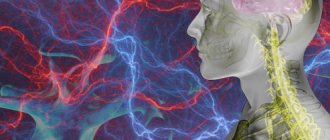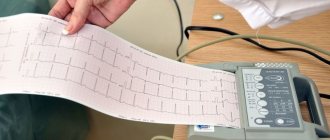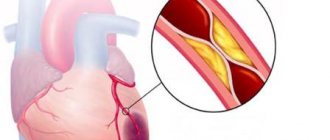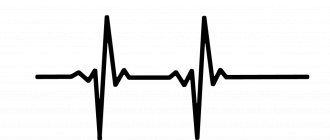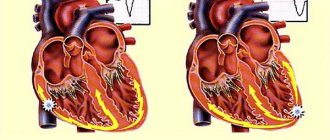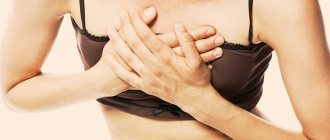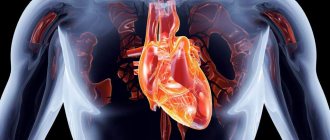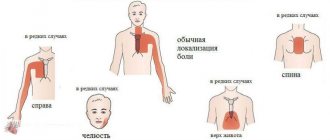- home
- Articles about cholelithiasis
- This is useful to know
- About the structure of the human body
- Catalog of useful medical articles
›
›
›
›
The heart is located in the center of the chest.
It is densely surrounded by other organs and anatomical structures. In this article we will look at what is below the heart. Sections of the article
Diaphragm
What organ is located under the heart?
Left lobe of the liver
Stomach
Pancreas
Causes of pain
Pancreatitis
Inflammation of the pancreas is the most common factor causing pain on the left side under the ribs. A number of reasons can cause inflammation of an organ:
- alcohol abuse;
- binge eating;
- cholelithiasis;
- viral lesions;
- injuries of the upper floor of the abdominal cavity;
- Helicobacter pylori infection;
- complications after operations and manipulations (endoscopy).
An attack of pancreatitis is characterized by severe pain under the left rib, radiating to the back and shoulder. Often people complain of a sharp girdling pain, combined with uncontrollable vomiting.
With chronic inflammation, the pain syndrome has a dull, aching character, intensifying against the background of physical activity, overeating, alcohol abuse or excessive consumption of fresh fruit. This form of the disease is a logical continuation of untreated acute pancreatitis.
Relief of pain in acute pancreatitis consists of therapy aimed at eliminating its cause - inflammation of the pancreas. In addition, for symptomatic purposes, analgesics are prescribed and novocaine blockades are carried out. The introduction of a local anesthetic to the organ bed in the acute phase of the inflammatory process significantly relieves its painful manifestations.
Intercostal neuralgia
Osteochondrosis, herniated intervertebral discs, and compression fractures of the vertebrae due to osteoporosis often serve as a trigger for sharp pain in the left hypochondrium. Unpleasant stabbing sensations begin behind the spine with a sudden attack. The mechanism of this pathology is compression of the intercostal nerves by the structures of the spinal column. Neuralgia can simulate some diseases of the abdominal organs. Its distinctive features:
- sharp pain under the left rib behind, starting from the vertebrae;
- the beginning is associated with a sudden movement;
- the pain worsens when turning or simply bending the body;
- may disappear when stationary;
- there are no dyspeptic symptoms (nausea, vomiting, bloating, changes in stool character).
Another feature of the pain syndrome is its rapid relief after an injection of an anti-inflammatory drug (diclofenac, dicloberl) or a manual therapy session. In the absence of proper care and elimination of the cause, attacks of neuralgia recur periodically.
Peptic ulcer
Aching pain under the left rib in the front is provoked by a stomach or duodenal ulcer. It is localized below the xiphoid process or, popularly, “in the pit of the stomach.” There is a clear connection with food, thanks to which the presumptive localization of the ulcerative defect is established:
- pain immediately after eating corresponds to an ulcer of the entrance (cardiac) section and body of the organ;
- symptoms appear a few hours later with an ulcer of the exiting section;
- night pain is predominant for a defect in the duodenal mucosa.
In addition, peptic ulcer disease is characterized by dyspeptic symptoms. Similar symptoms and aching pain under the left rib can also be observed with a diaphragmatic hernia. A distinctive feature of a hernia is early vomiting after eating, which brings relief. It is also characterized by a specific symptom - lying down immediately after eating causes regurgitation of gastric juice into the esophagus, manifested by an unbearable sour taste in the mouth.
The pain of a peptic ulcer disappears or is significantly reduced by diet and taking medications that reduce acidity.
Injury
The lateral walls of the abdomen and chest are rich in nerve endings, which, if traumatically damaged, cause pain. After a rib fracture, it persists for several months. It is relieved after taking analgesics and local anti-inflammatory compresses.
The main danger of injury to the left costal arch is not considered to be a fracture of the ribs, but damage to the internal organs. The etiology of severe pain under the left rib may be a rupture of the spleen - a condition that threatens massive intra-abdominal hemorrhage.
When an organ ruptures, pain radiates to the lower abdominal wall, where blood flows, and the left shoulder, which is associated with irritation of the fibers of the phrenic nerve. There is also a specific sign for this injury. When a person tries to lie down, the pain in the abdomen and shoulder increases sharply, causing him to quickly get up. In the medical literature, this is called the “vanka-vstanka” symptom.
A splenic rupture is a serious condition that requires immediate surgical intervention. In most cases, the essence of the operation is the complete removal of an organ that no longer performs vital functions in adults. In extremely rare cases, when the patient’s condition is stable and the degree of organ destruction is insignificant, it is possible to perform organ-saving surgery.
Heart diseases
Dull pain under the left rib is a manifestation of angina pectoris and myocardial infarction, when delay and incorrect diagnosis have a poor prognosis. Treatment of pancreatitis, neuralgia or ulcers during an acute heart attack is worse than absolute inactivity. It is advisable to remember the symptoms accompanying the abdominal form of myocardial infarction:
- chest pain;
- numbness of the left hand;
- dyspnea;
- cardiopalmus;
- pallor.
For these symptoms, an electrocardiogram should be the leading diagnostic procedure, without which treatment cannot be started. Pain relief for a heart attack involves the administration of narcotic analgesics and the use of nitroglycerin tablets. If this diagnosis is suspected, an ambulance should be called immediately.
Pneumonia and pleurisy
Inflammation of the lung or pleura covering this organ is a potential cause of pain in the area of the left costal arch. The stabbing pain intensifies with deep inhalation and finger pressure on the intercostal spaces. These diseases occur against the background of a cold and, in addition to pain, are accompanied by a number of symptoms:
- febrile temperature;
- dyspnea;
- dry cough;
- lag of the left half of the chest in the act of breathing;
- smoothing of intercostal spaces.
Pain relief occurs virtually independently after the start of treatment for the underlying problem. For this purpose, antibacterial drugs, anti-inflammatory, antitussive and expectorant drugs are used. In cases of exudative pleurisy, when fluid accumulates in the pleural cavity, it may be necessary to perform puncture and aspiration of inflammatory exudate.
Colon diseases
On the left in the hypochondrium is the splenic angle of the colon. When it is inflamed, torsion, or a tumor, pain may occur in this area. It is often accompanied by some of the symptoms:
- pathological impurities in feces (mucus, blood, pus);
- diarrhea or constipation;
- bloating;
- increased gas formation;
- dyspepsia;
- absence of gas and stool.
Delay in such a case threatens surgical intervention. Therefore, if you have such symptoms, you should immediately go to the hospital. Pain syndrome in pathology of the colon is rarely the leading symptom, so it quickly stops after eliminating the root cause of the disease.
Renal colic
Stones or sand in the urinary tract are a likely cause of obstruction of the flow of urine into the bladder from the kidneys. In such situations, increased pressure occurs in the pelvis of the latter, the tissue and capsule of the organ stretches, and severe pain occurs. Acute piercing pain is predominantly localized under the ribs at the back. Such an attack is accompanied by a disturbance in the nature of urination in the form of retention, frequent urge or bloody urine. Patients are always restless, it is difficult for them to find a place or a comfortable position in which the attack would not be so pronounced.
Emergency care for renal colic involves administering a combination of various anti-inflammatory, analgesic and antispasmodic drugs. More often than not, the pain subsides after this. To prevent a recurrent attack, it is recommended to take a hot bath, place a heating pad on the painful area, or drink a small amount of strong alcohol. These activities lead to relaxation of the smooth muscles of the urinary tract, the passage of small stones and sand. Subsequently, the patient needs a mandatory scheduled consultation with a urologist to determine the tactics for further treatment of urolithiasis.
Shingles
The chickenpox virus, after the symptoms of the disease subside, does not leave the human body, but is sent to the ganglia of the spinal nerves, where it remains in an inactive state. In case of weakened immunity, hypothermia and other aggravating circumstances, the virus can be activated. But in these cases, it no longer causes chickenpox, but a disease called herpes zoster.
The clinical picture is characterized by burning pain spreading from the spine along the intercostal space. After a few days, small vesicles appear in this place, reminiscent of herpes rashes on the lips. Even later, the vesicles burst and wounds appear, causing a lot of inconvenience to the person. The pathology is characterized by malaise and low-grade fever.
Diagnosis of pain in the heart area when inhaling
What to do when I breathe and my heart hurts? Contact specialists at the KDS Clinic. Medical workers will conduct a comprehensive examination, diagnose the disease even at an early stage, and prescribe effective and affordable treatment. Pain in the heart area when inhaling indicates impaired functioning of the internal organs. We are talking not only about the cardiovascular system, but also about neighboring organs that can load the heart, thereby causing discomfort. If the patient feels a sharp nagging pain, he should change his position and take painkillers.
If these symptoms occur regularly, it is worth getting tested. Visit a cardiologist and TB specialist. He will direct the patient to undergo tests, including stool, urine, biochemistry and blood tests. With the help of tests, the condition of all indicators of the body will be diagnosed. The patient may be referred for an electrocardiogram, radiography and ultrasound diagnostics. If we are talking about lung disease, then auscultation of the lungs will be performed at a medical institution. To diagnose the cardiovascular system, the patient remains in the hospital where he undergoes a Holter examination. Over the course of several days, doctors observe changes in the patient’s condition and study the dynamics.
If you feel pain in the heart area when you inhale, do not worry and go to the clinic as soon as possible, where they will conduct a comprehensive diagnosis using modern equipment. In most cases, surgery will not be required. Even in advanced cases, doctors will find an effective solution to the problem. When your heart hurts when you inhale, make an appointment with a specialist by number.
Treatment
For treatment, in addition to analgesics, antiviral agents are used to eliminate the cause of the disease.
As already mentioned, pain in the left hypochondrium is just a symptom and not an independent disease. When it first appears, a mandatory comprehensive examination is necessary to help identify the cause of the painful condition and prevent its occurrence in the future. Otherwise, the process may become chronic, threatening constant pain, which leads to apathy, depression and other psychological disorders.
Call our contact center at 8 (495) 230 03 09 and we will help you make an appointment with a specialist!
